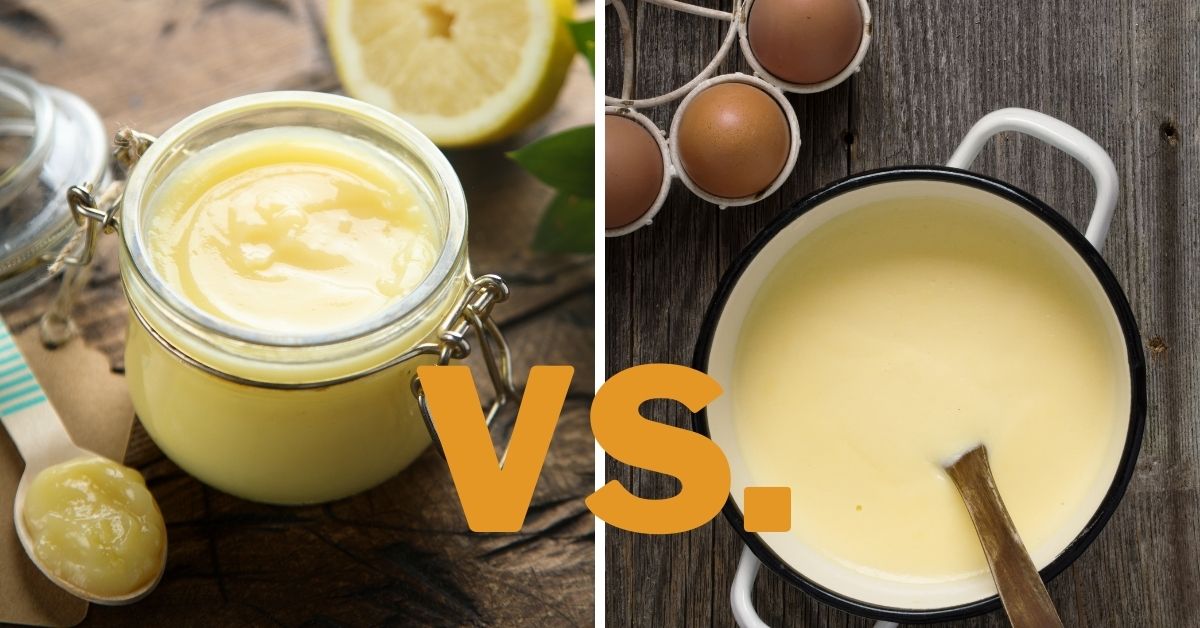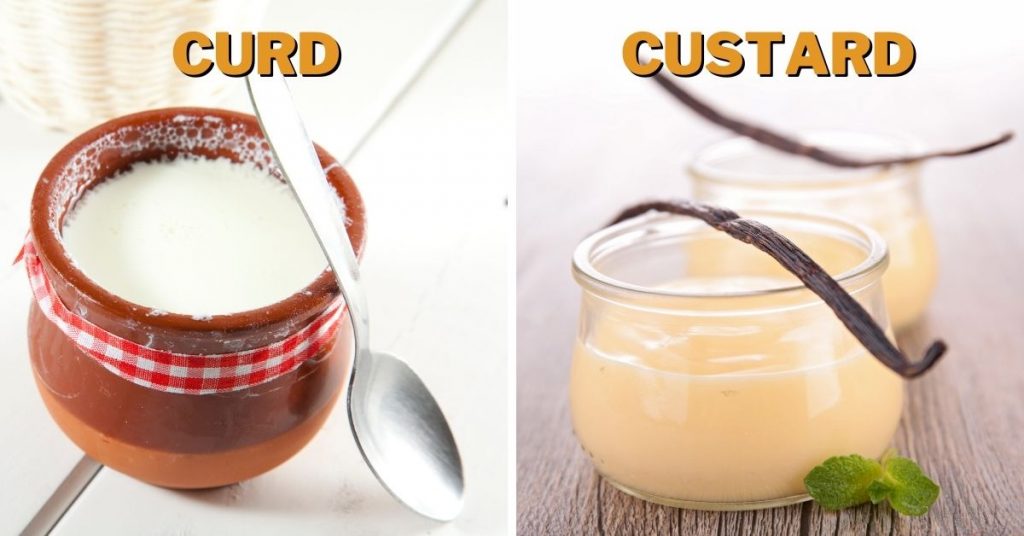Curd vs. Custard: Differences & Which Is Better?

Curd and custard are two entirely different products that can be used for the same purposes, for example in a dessert. Whether combined or on their own, both can be very tasty, as well as rich and nutritious. However, despite having many advantages in taste and nutritional value, they also have some disadvantages. So, what are the differences between curd and custard, and which is better?
Curd is coagulated milk by adding acidic substances such as lemon juice, vinegar, or rennet. Custard is a mixture of milk, cream, egg yolks, and sugar as compulsory elements and flavoring agent as an optional addition. Both have their strengths and weaknesses and shine best when properly used.
Because both curd and custard are excellent additions to many of my meals, both these products have a very special place in my kitchen. Their use is very wide, and they easily fit into many combinations, so having that many options gave me much space to explore and experiment. In the following paragraphs, I will explain their differences, how they are made, whether you can substitute one for the other, and which is better.
Curd vs. Custard: Differences
Although their uses often overlap, curd and custard are different products, starting from their production processes, taste, and texture.
Production
Curd is coagulated milk by adding an acidic agent such as vinegar, lemon, or rennet. When the acidic agent is added to the warm milk, it triggers a chemical reaction, solidifying the milk in pieces- curds. Curd can either be a finished product, ready for use on its own, or the initial stage of cheese making.
This process doesn’t necessarily have to be triggered by adding the agent; the curdling can also happen naturally. If you leave the milk at room temperature, it will curdle on itself; after about 78 hours, you will have curd.
On the other hand, Custard isn’t obtained from a single ingredient but is a mixture of milk, cream, egg yolks, and sugar. Often, the custard can be enriched by a flavoring agent to give it some specific taste.
Just like curd, custard can also be made at home, though slightly complex. While curd only needs time, custard also requires some effort. You need to add the ingredients one by one, heat them and mix after each ingredient.
Both curd and custard can be made at home, as their production processes are pretty straightforward.
Taste
Since curd is fermented milk, its taste is milky, fresh, and mildly salty. The salt amount in the curd is the natural salt of the product; there’s no extra added. Curd is, however, neutral-tasting, as the salt amount is very discreet, and it amplifies the other flavors more than it gives a salty taste to the product.
Because of the fermentation process, the curd is also mildly tangy and very rich. Still, since none of its flavors is expressive and overwhelming, the curd is considered overall mild and creamy, making it suitable for use in sweet and savory dishes.
On the other hand, Custard has a distinct eggy and mildly sweet flavor because of the added sugar. However, just like the discrete saltiness of the curd, the sweetness of the custard is also very mild. Still, the mildly sweet flavor of the custard makes it a perfect solution for a dessert topping or dessert filling.
There is, however, a variation of custard, savory custard. The savory custard contains the same ingredients as regular custard, including salt and spices. You can use this custard type for savory dishes, and it is an excellent choice for dip or filling.
Despite having recognizable tastes, both curd and custard fall into the neutral-tasting products category since none of their flavors is too expressed, making them distinctly sweet, salty, or sour. However, the custard is heavier than curd, which is understandable since it contains cream, and curd is fresher than custard, typical for dairy products obtained through fermentation.
The texture of custard varies depending on the number of egg yolks as a primary thickener, but also on adding or not adding other thickeners, such as flour or corn starch. Texture-wise, they are both creamy and very smooth. While curd doesn’t vary in texture and always has the same smoothness, creaminess, and softness, custard can vary from thick liquid to thick cream.

Which Is More Popular?
Both curd and custard are very popular and very common in terms of popularity. You can use them both for sweet and savory dishes (savory custard).
Curd is easier to make, you just leave the milk to thicken, and it is done. Custard does require some effort, but not too much, though. Therefore, since both products are relatively easy to make, their popularity doesn’t depend on that. Both are good and nutritious, though custard is fattier than curd.
So, it is safe to say that curd and custard are equally popular, and what you use depends on your taste and preferences, as well as the dish you are making.
Use
Since it is neutral-tasting, the curd is very easy to combine, and therefore you can add it to wherever you need more creaminess and structure.
Curd does excellent as a dip, as a base for fruit smoothies, as a spread on baked goods, as a frozen dessert, or as a salad addition, but you can also have it with no extras, plain. [1]
Since it is the base for cheese, the curd is also a great low-fat addition to cheesecake, though your cheesecake could taste a bit tangy. Also, curd tends to be more watery than cream cheese, so you might need to add a thickener such as buttermilk to make it more stable.
You should avoid combining curd with milk, as they come from the same family are rich in protein. The two contain animal-derived protein and could cause digestive distress. Another combination to avoid is fish and curd, again due to the proteins.
Onion and curd are also not a good idea, as curd is refreshing and cools the body, while onions produce heat while digesting. This could lead to health problems such as skin rashes and indigestion. [2]
Custard is traditionally used for desserts. In the desert area, it has multiple uses; it can be a topping, filling, pie crust, and even a sweet sauce. It is also known for its use in cheesecakes and sweet pies.
Savory custard is known for quiches or a thick sauce base. It also goes great in savory pies and spread on savory or neutral-tasting pastries.
Can You Substitute Curd for Custard?
Curd can substitute for custard in desserts such as cheesecake, frozen desserts, or pastry spread. You can also use curd instead of savory custard as a sauce base. However, in cream pies, quiches, or filling, curd cannot substitute for custard.
Can You Substitute Custard for Curd?
You can substitute custard for curd, but not everywhere. The freshness the curd offers as a salad dressing or a dip cannot be doubled by the custard. So generally, wherever you use curd because of its freshness and mild tanginess, you cannot use custard instead.
A salad dressing, dip, a fruit smoothie, or custard cannot substitute for the curd to add creaminess. However, the custard is a good substitute for curd in cheesecake, pastry spread, or a savory sauce base.
How Are Curd and Custard Similar to Pudding?
Texture-wise you could find some similarities between custard, curd, and pudding. The three are creamy, smooth, and thick. However, custard and curd are different than pudding. While curd doesn’t contain any thickeners, the primary thickener in custard are egg yolks, and pudding contains corn starch as a compulsory thickening agent. In contrast, corn starch is an optional ingredient in custard.
Also, pudding is expressively sweet and is a dessert in itself, while curd and custard are mild and neutral-tasting and are mainly used as an ingredient to another sweet or savory dish.
While curd is a dairy product, and custard is a mixture of several ingredients, pudding is essentially thickened milk by adding flavored thickener, making the pudding production process straightforward and quick.
Curd vs. Custard: Which Is Better?
To say that one is better wouldn’t be fair to either curd or custard. Both have their culinary strengths and do their best when properly used. None of them is better, but rather, they are both good in their domains.
While curd is excellent for salads and smoothies, the custard is irreplaceable for desserts, whether filling or topping.
If, however, you are looking for the healthier option, that would be curd because custard is significantly fattier and higher in calories due to the cream and eggs, which are its key ingredients. [3]
